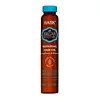What's inside
What's inside
 Key Ingredients
Key Ingredients

 Benefits
Benefits

 Concerns
Concerns

 Ingredients Side-by-side
Ingredients Side-by-side

Water
Skin ConditioningCocamidopropyl Betaine
CleansingDisodium Laureth Sulfosuccinate
CleansingLauramine Oxide
CleansingTea-Cocoyl Glutamate
CleansingGlycerin
HumectantButylene Glycol
HumectantLauramide DEA
PEG-120 Methyl Glucose Dioleate
EmulsifyingSodium Chloride
MaskingSodium Benzoate
MaskingPEG-7 Glyceryl Cocoate
EmulsifyingPPG-3 Caprylyl Ether
SolventCitric Acid
BufferingPolyquaternium-10
Betaine
HumectantChitosan
1,2-Hexanediol
Skin ConditioningHydrolyzed Wheat Protein
Skin ConditioningHydrolyzed Soy Protein
HumectantHydrolyzed Corn Protein
Skin ConditioningEthylhexylglycerin
Skin ConditioningHydrolyzed Silk
HumectantHydroxyacetophenone
AntioxidantSodium Hyaluronate
HumectantTrehalose
HumectantDipropylene Glycol
HumectantZein
Skin ConditioningArgania Spinosa Kernel Oil
EmollientPersea Gratissima Oil
Skin ConditioningCamellia Japonica Seed Oil
EmollientSimmondsia Chinensis Seed Oil
EmollientHydrolyzed Keratin
HumectantPentylene Glycol
Skin ConditioningBenzyl Salicylate
PerfumingCitronellol
PerfumingHexyl Cinnamal
PerfumingHydroxycitronellal
PerfumingParfum
MaskingWater, Cocamidopropyl Betaine, Disodium Laureth Sulfosuccinate, Lauramine Oxide, Tea-Cocoyl Glutamate, Glycerin, Butylene Glycol, Lauramide DEA, PEG-120 Methyl Glucose Dioleate, Sodium Chloride, Sodium Benzoate, PEG-7 Glyceryl Cocoate, PPG-3 Caprylyl Ether, Citric Acid, Polyquaternium-10, Betaine, Chitosan, 1,2-Hexanediol, Hydrolyzed Wheat Protein, Hydrolyzed Soy Protein, Hydrolyzed Corn Protein, Ethylhexylglycerin, Hydrolyzed Silk, Hydroxyacetophenone, Sodium Hyaluronate, Trehalose, Dipropylene Glycol, Zein, Argania Spinosa Kernel Oil, Persea Gratissima Oil, Camellia Japonica Seed Oil, Simmondsia Chinensis Seed Oil, Hydrolyzed Keratin, Pentylene Glycol, Benzyl Salicylate, Citronellol, Hexyl Cinnamal, Hydroxycitronellal, Parfum
Cyclopentasiloxane
EmollientDimethiconol
EmollientArgania Spinosa Kernel Oil
EmollientKeratin Amino Acids
Skin ConditioningGlycine Soja Oil
EmollientVitis Vinifera Seed Oil
EmollientCitrus Aurantium Dulcis Oil
MaskingTocopherol
AntioxidantWater
Skin ConditioningButylene Glycol
HumectantPhenoxyethanol
PreservativeEthylhexylglycerin
Skin ConditioningCitral
PerfumingLimonene
PerfumingLinalool
PerfumingCI 26100
Cosmetic ColorantCI 47000
Cosmetic ColorantIngredients Explained
These ingredients are found in both products.
Ingredients higher up in an ingredient list are typically present in a larger amount.
You may know this ingredient as argan oil. Argan Oil has antioxidant, hydrating, and soothing properties.
Studies have shown argan oil can help fight again radical damage from the sun. This makes it effective at preventing hyperpigmentation.
Large amounts of vitamin E found in argan oil helps the skin retain water. Argan oil also contains fatty acids such as linoleic acid, oleic acid, and palmitic acid. It is also a good source of lipids.
Another benefit of argan oil is skin-soothing. It can help reduce inflammation-related skin symptoms.
Argan Oil is effective at regulating sebum production in pores. This can make it effective at treating hormonal acne.
Traditionally, argan oil was used for its antibacterial and antifungal properties. However, argan oil contains fatty acids that may make it not fungal-acne safe.
Argan Trees are native to Morocco.
Learn more about Argania Spinosa Kernel OilButylene Glycol (or BG) is used within cosmetic products for a few different reasons:
Overall, Butylene Glycol is a safe and well-rounded ingredient that works well with other ingredients.
Though this ingredient works well with most skin types, some people with sensitive skin may experience a reaction such as allergic rashes, closed comedones, or itchiness.
Learn more about Butylene GlycolEthylhexylglycerin (we can't pronounce this either) is commonly used as a preservative and skin softener. It is derived from glyceryl.
You might see Ethylhexylglycerin often paired with other preservatives such as phenoxyethanol. Ethylhexylglycerin has been found to increase the effectiveness of these other preservatives.
Water. It's the most common cosmetic ingredient of all. You'll usually see it at the top of ingredient lists, meaning that it makes up the largest part of the product.
So why is it so popular? Water most often acts as a solvent - this means that it helps dissolve other ingredients into the formulation.
You'll also recognize water as that liquid we all need to stay alive. If you see this, drink a glass of water. Stay hydrated!
Learn more about Water